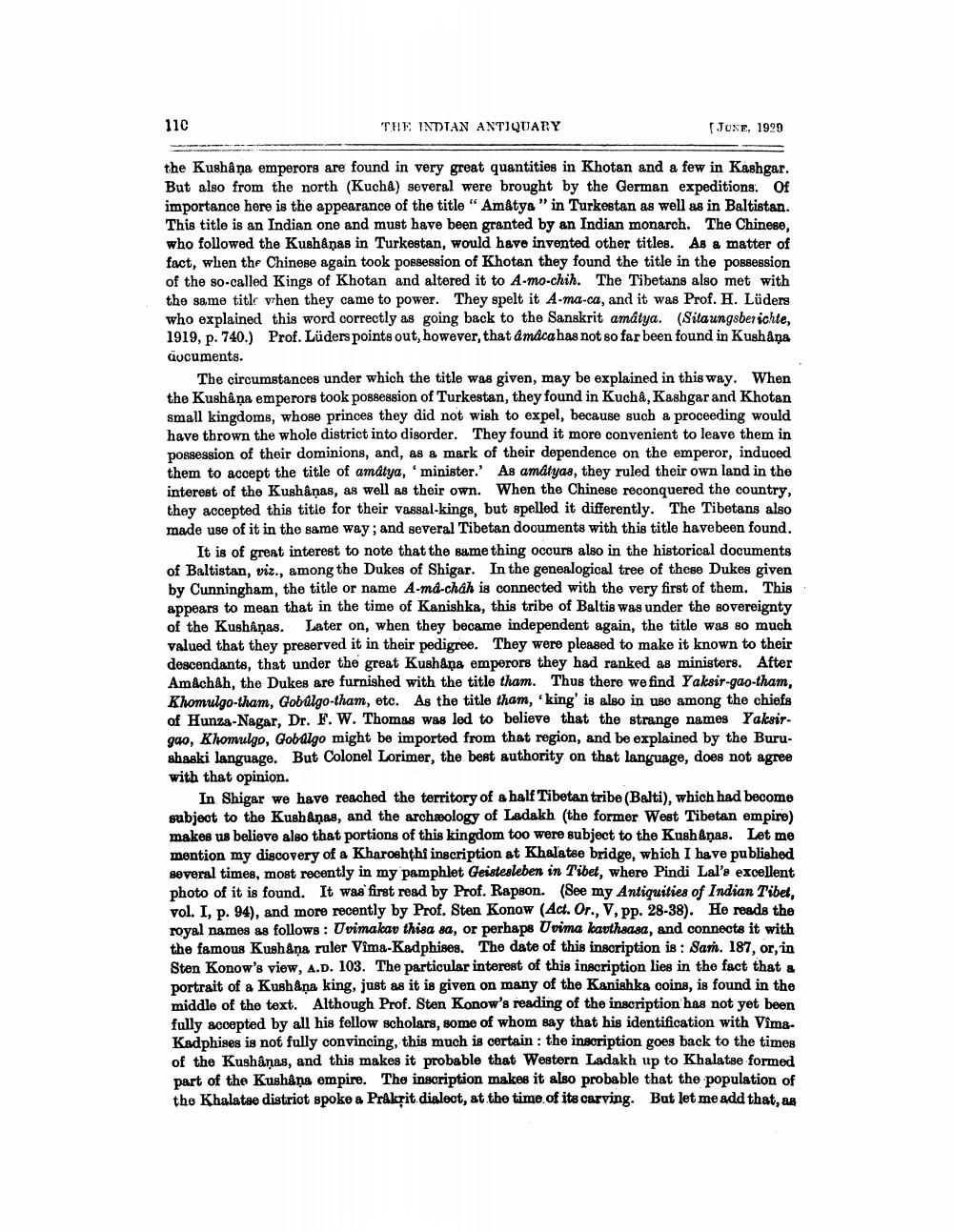________________
110
THE INDIAN ANTIQUARY
(JUXE, 1929
the Kushâņa emperors are found in very great quantities in Khotan and a few in Kashgar. But also from the north (Kucha) several were brought by the German expeditions. Of importance here is the appearance of the title “ Amatya" in Turkestan as well as in Baltistan. This title is an Indian one and must have been granted by an Indian monarch. The Chinese, who followed the Kushåņas in Turkestan, would have invented other titles. As a matter of fact, when the Chinese again took possession of Khotan they found the title in the possession of the so-called Kings of Khotan and altered it to A-mo-chih. The Tibetans also met with the same title when they came to power. They spelt it A-ma-ca, and it was Prof. H. Lüders who explained this word correctly as going back to the Sanskrit amâtya. (Sitaungsberichte, 1919, p. 740.) Prof. Lüders points out, however, that amaca has not so far been found in Kushana documents.
The circumstances under which the title was given, may be explained in this way. When the Kushâņa emperors took possession of Turkestan, they found in Kucha, Kashgar and Khotan small kingdoms, whose princes they did not wish to expel, because such a proceeding would have thrown the whole district into disorder. They found it more convenient to leave them in possession of their dominions, and, as a mark of their dependence on the emperor, induced them to accept the title of amatya, 'minister. As amatyas, they ruled their own land in the interest of the Kushâņas, as well as their own. When the Chinese reconquered the country, they accepted this title for their vassal-kings, but spelled it differently. The Tibetans also made use of it in the same way; and several Tibetan doouments with this title have been found.
It is of great interest to note that the same thing occurs also in the historical documents of Baltistan, viz., among the Dukes of Shigar. In the genealogical tree of these Dukes given by Cunningham, the title or name A-md-chah is connected with the very first of them. This appears to mean that in the time of Kanishka, this tribe of Baltis was under the sovereignty of the Kushånas. Later on, when they became independent again, the title was so much valued that they preserved it in their pedigree. They were pleased to make it known to their descendants, that under the great Kushåņa emperors they had ranked as ministers. After Amâchåh, the Dukes are furnished with the title tham. Thus there we find Yaksir-gao-tham, Khomulgo-tham, Gobúlgo-tham, etc. As the title tham, 'king' is also in use among the chiefs of Hunza-Nagar, Dr. F. W. Thomas was led to believe that the strange names Yaksirgao, Khomulgo, Gobalgo might be imported from that region, and be explained by the Burushaski language. But Colonel Lorimer, the best authority on that language, does not agree with that opinion.
In Shigar we have reached the territory of a half Tibetan tribe (Balti), which had become subjeot to the Kush Aņas, and the archæology of Ladakh (the former West Tibetan empire) makes us believe also that portions of this kingdom too were subject to the Kush &ņas. Let me mention my discovery of a Kharoshthi inscription at Khalatee bridge, which I have published several times, most recently in my pamphlet Geistesleben in Tibet, where Pindi Lal'e excellent photo of it is found. It was first read by Prof. Rapson. (See my Antiquities of Indian Tibet, vol. I, p. 94), and more recently by Prof. Sten Konow (Act. Or., V, pp. 28-38). He reads the royal names as follows: Uvimakav thisa sa, or perhaps Uvima kavthaasa, and connects it with the famous Kush&na ruler Vima-Kadphises. The date of this inscription is : Sam. 187, or, in Sten Konow's view, A.D. 103. The particular interest of this inscription lies in the fact that a portrait of a Kushana king, just as it is given on many of the Kanishka coins, is found in the middle of the text. Although Prof. Sten Konow's reading of the inscription has not yet been fully accepted by all his fellow scholars, some of whom say that his identification with Vima. Kadphises is not fully convincing, this much is certain : the inscription goes back to the times of the Kushanas, and this makes it probable that Western Ladakh up to Khalatse formed part of the Kushåņa empire. The inscription makes it also probable that the population of the Khalatse distriot spoke a Prakrit dialect, at the time of its carving. But let me add that, as




